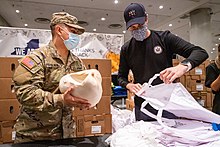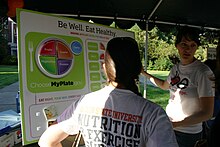User:AlyssaLicata/Human nutrition
| This is the sandbox page where you will draft your initial Wikipedia contribution.
If you're starting a new article, you can develop it here until it's ready to go live. If you're working on improvements to an existing article, copy only one section at a time of the article to this sandbox to work on, and be sure to use an edit summary linking to the article you copied from. Do not copy over the entire article. You can find additional instructions here. Remember to save your work regularly using the "Publish page" button. (It just means 'save'; it will still be in the sandbox.) You can add bold formatting to your additions to differentiate them from existing content. |
Article Draft
[edit]Lead
[edit]Article body
[edit]United States
[edit]In the United States, 2% of children are underweight, with under 1% stunted and 6% are wasting.[1]

In the US, dietitians are registered (RD) or licensed (LD) with the Commission for Dietetic Registration and the American Dietetic Association, and are only able to use the title "dietitian", as described by the business and professions codes of each respective state, when they have met specific educational and experiential prerequisites and passed a national registration or licensure examination, respectively. Anyone may call themselves a nutritionist, including unqualified dietitians, as this term is unregulated.[citation needed] Some states, such as the State of Florida, have begun to include the title "nutritionist" in state licensure requirements. Most governments provide guidance on nutrition, and some also impose mandatory disclosure/labeling requirements for processed food manufacturers and restaurants to assist consumers in complying with such guidance.[citation needed]
In the US, nutritional standards and recommendations are established jointly by the US Department of Agriculture and US Department of Health and Human Services. Dietary and physical activity guidelines from the USDA are presented in the concept of a plate of food which in 2011 superseded the MyPyramid food pyramid that had replaced the Four Food Groups. The Senate committee currently responsible for oversight of the USDA is the Agriculture, Nutrition and Forestry Committee. Committee hearings are often televised on C-SPAN. The U.S. Department of Health and Human Services provides a sample week-long menu which fulfills the nutritional recommendations of the government.[2] Canada's Food Guide is another governmental recommendation.[citation needed]
Advice and guidance
[edit]Government policies
[edit]
Canada's Food Guide is an example of a government-run nutrition program. Produced by Health Canada, the guide advises food quantities, provides education on balanced nutrition, and promotes physical activity in accordance with government-mandated nutrient needs. Like other nutrition programs around the world, Canada's Food Guide divides nutrition into four main food groups: vegetables and fruit, grain products, milk and alternatives, and meat and alternatives.[3] Unlike its American counterpart, the Canadian guide references and provides alternative to meat and dairy, which can be attributed to the growing vegan and vegetarian movements.
In the US, nutritional standards and recommendations are established jointly by the US Department of Agriculture and US Department of Health and Human Services (HHS) and these recommendations are published as the Dietary Guidelines for Americans. Dietary and physical activity guidelines from the USDA are presented in the concept of MyPlate, which superseded the food pyramid, which replaced the Four Food Groups. The Senate committee currently responsible for oversight of the USDA is the Agriculture, Nutrition and Forestry Committee. Committee hearings are often televised on C-SPAN. The U.S. HHS provides a sample week-long menu that fulfills the nutritional recommendations of the government.[4]
References
[edit]- ^ Progress for Children: A Report Card on Nutrition (No. 4), UNICEF, May 2006, ISBN 978-92-806-3988-9 www.ventes.le-vel.ca /nutrition/index_33685.html
- ^ "Archived copy" (PDF). Archived from the original (PDF) on 2008-03-08. Retrieved 2008-03-08.
{{cite web}}: CS1 maint: archived copy as title (link) - ^ Canada's Food Guide. Health Canada
- ^ Sample Menus for a 2000 Calorie Food Pattern. mypyramid.gov
